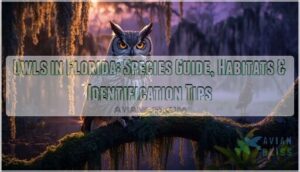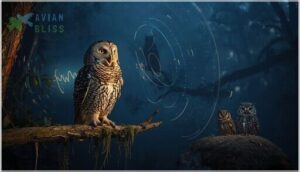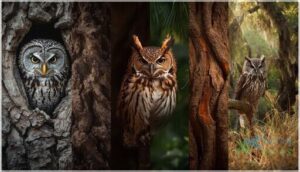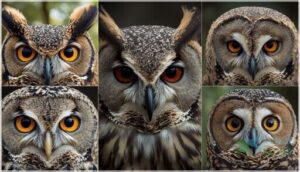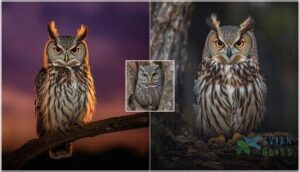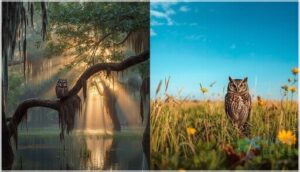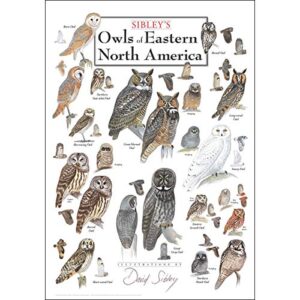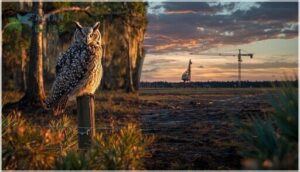This site is supported by our readers. We may earn a commission, at no cost to you, if you purchase through links.
When the sun sets over Florida’s sprawling landscapes, a hidden world awakens. Six native owl species call this state home year-round, from the powerful Great Horned Owl patrolling the pine forests to the quirky Burrowing Owl standing guard outside its underground den in suburban parking lots.
These nocturnal hunters have adapted to nearly every Florida habitat you can imagine—dense swamps, open prairies, coastal marshes, and even your neighborhood park. Learning to identify them isn’t as difficult as you might think. Each species carries distinctive traits, from the Barred Owl’s unmistakable “Who cooks for you?” call echoing through cypress swamps to the Eastern Screech-Owl’s descending whinny that sounds nothing like a screech.
Whether you’re a backyard birder or just curious about the feathered night shift in your area, recognizing these fascinating birds opens up a whole new dimension of Florida’s wildlife.
Table Of Contents
- Key Takeaways
- Native Owl Species in Florida
- Identifying Florida Owls by Features
- Owl Habitats and Range in Florida
- Top 4 Owl Field Guides
- Conservation Status and Threats
- Frequently Asked Questions (FAQs)
- Is it good to have an owl in your yard?
- What type of owls live in Florida?
- Do owls come out during the day in Florida?
- What do Florida owls eat?
- Are owls in Florida protected by law from hunting?
- How do owls in Florida adapt to extreme weather conditions?
- Can owls in Florida be kept as pets legally?
- What role do owls play in Floridas ecosystem balance?
- How do owls in Florida respond to human presence and noise?
- What do owls eat and how do they hunt?
- Conclusion
Key Takeaways
- Florida is home to six year-round native owl species—Great Horned, Barred, Eastern Screech, Burrowing, Barn, and Short-eared Owls—each adapted to specific habitats from dense swamps to suburban parking lots, making identification accessible through distinctive calls, eye colors, and physical features.
- Burrowing Owls represent a conservation success story in Florida, particularly in Cape Coral where over 7,000 individuals thrive in urban landscapes, though they face ongoing threats from habitat loss as development exceeds 60% build-out thresholds.
- Florida’s owls provide critical ecosystem services by controlling rodent and insect populations naturally, with Barn Owls in agricultural areas consuming up to 90% rodents and entire owl families eliminating thousands of pests per season.
- State and federal protections prohibit hunting or disturbing any owl species in Florida, with the Burrowing Owl listed as State Threatened since 2017, requiring special permits and habitat buffers during development projects to protect nesting sites.
Native Owl Species in Florida
Florida’s night skies come alive with the calls and silent flights of at least six native owl species, each adapted to different corners of the state. From massive predators to tiny cavity dwellers, these birds have carved out niches in forests, grasslands, and even busy neighborhoods.
Let’s meet the owls you’re most likely to encounter across Florida’s diverse landscapes.
Great Horned Owl
The Great Horned Owl is among Florida’s most powerful owl species. You’ll recognize these year-round residents by their prominent ear tufts and piercing yellow eyes.
They hunt primarily at night, using silent flight to capture prey—mostly small mammals like mice and squirrels that make up about 90% of their diet. Their deep, resonant hoots echo through forests, swamps, and even suburban parks across the state.
These owls are found across North America.
Eastern Screech Owl
Unlike the powerful Great Horned Owl, the Eastern Screech-Owl is much smaller but thrives across Florida’s woodlands, suburbs, and parks. You’ll hear its descending whinny call at night. Remarkably, urban ecology studies show these owls achieve higher nesting success in suburban areas than rural sites, though rodenticide poisoning and territory abandonment remain serious threats. Remote tracking helps monitor their habitat selection.
- Small, mottled owl in gray or reddish color phases
- Nests in natural tree cavities and backyard nest boxes
- Juvenile survival drops sharply after fledging
- Feeds on insects, small rodents, and songbirds
Barred Owl
If you’ve heard a loud “Who cooks for you?” echoing through Florida’s forests at dusk, you’ve met the Barred Owl. This medium-sized bird thrives in forest habitats with mature trees and wooded swamps, using vocal communication for territorial defense year-round.
Nesting habits involve reusing tree cavities 20-40 feet high, and diet diversity includes rodents, rabbits, and even fish. Range expansion westward continues, making owl identification easier across varied owl habitats.
Burrowing Owl
While forest owls occupy tree cavities, the Burrowing Owl breaks the mold entirely. You’ll spot this small, long-legged bird standing sentinel outside underground burrows on golf courses, vacant lots, and airports across peninsular Florida.
Unlike other Florida owls, these ground-dwellers prefer open habitats where they hunt insects and small rodents. Cape Coral maintains over 7,000 individuals, the largest urban population recorded under intensive conservation management.
Cape Coral’s Burrowing Owls thrive in open habitats where over 7,000 ground-dwelling individuals hunt beneath Florida’s grasslands and prairies
Barn Owl
With its heart-shaped white face and dark eyes, the Barn Owl glides on silent flight over Florida’s agricultural fields and marshes, hunting rodents that threaten crops.
You’ll find these ghostly nocturnal hunters nesting in barns, tree cavities, and nest boxes throughout the state, where a single family can consume thousands of rodents per season.
Though not currently threatened in Florida, habitat loss and rodenticide exposure pose ongoing conservation challenges.
Short-eared Owl
You’ll spot the Short-eared Owl during crepuscular hunting over northern Florida’s open grasslands and fields from late December through February, when these nomadic visitors arrive at their southern wintering grounds.
These rare winter migrants show strong habitat preference for prairies and marshes, where they hunt low over vegetation in their distinctive moth-like flight pattern.
Population declines across North America make each sighting in Florida significant.
Rare and Accidental Owl Visitors
Occasionally, four rare owl species appear as accidental visitors during unusual irruption events or notable winters. These migratory owls face identification challenges and habitat mismatch in Florida, making conservation concerns particularly relevant for future sightings:
- Snowy Owl – Arctic wanderer appearing only during major food-driven movements
- Long-eared Owl – Exceedingly rare winter vagrant from northern breeding grounds
- Northern Saw-whet Owl – Tiny boreal visitor reaching Florida in unusual years
- Flammulated Owl – Western montane species requiring review-committee documentation
- All four – Considered accidental compared to Florida’s six year-round resident owls
Identifying Florida Owls by Features
When you spot an owl in Florida, a few key features can help you identify which species you’re looking at. Size, coloring, and facial markings are your best starting points, but listening for their calls can also narrow things down quickly.
Let’s walk through the main features that make each Florida owl unique.
Size and Physical Characteristics
When you’re trying to identify owls in Florida, size dimorphism and wingspan variation become your best clues. The Great Horned Owl, the largest species, reaches 63 cm tall with wingspans up to 145 cm and weight ranges from 910 to 2,500 grams. In contrast, the tiny Eastern Screech Owl measures just 16–25 cm, weighing around 121–244 grams.
Plumage differences and feather adaptations also distinguish species—Burrowing Owls show white-spotted brown patterns, while Barn Owls display ghostly pale coloring.
Distinctive Calls and Vocalizations
You’ll recognize owls in Florida by their unique vocalizations—call identification is key. The Barred Owl’s eight-note hooting series carries through forests, while the Eastern Screech Owl produces soft trills and descending whinnies. Great Horned Owls deliver deep, territorial hoots strongest in winter, and Burrowing Owls use short, repetitive coos.
Temporal patterns matter too—Barn Owl screams peak after midnight during hunting activity.
Color Patterns and Camouflage
Owl identification in Florida hinges on recognizing how plumage variation aids predator evasion through habitat camouflage. Eastern Screech Owls show color morphs—gray blends with hardwood bark, red matches pines—while Barred Owls use brown barring for forest concealment.
Burrowing Owls wear sandy-brown spots mimicking open grasslands, and Barn Owls display pale underparts that improve nocturnal visibility under moonlight, affecting prey behavior during hunts.
Eye Color and Facial Features
Beyond camouflage patterns, eye morphology and facial features offer key identifications for Florida owls. Eye color separates species quickly—Great Horned and Burrowing Owls show bright yellow, while Barred Owls display distinctive dark brown eyes.
Notice these owl characteristics:
- Barn Owls present heart-shaped facial discs with dark eyes
- Eastern Screech Owls exhibit uniform yellow eyes across color morphs
- Burrowing Owls combine yellow eyes with bold white “eyebrows”
- Short-eared Owls wear dark eye patches creating a masked look
- Juvenile plumage shows eye color before full adult facial features develop
These sensory adaptations and facial asymmetry patterns aid your owl physical features identification skills.
Ear Tufts and Head Shape
While eyes reveal important clues, ear tufts and head shape provide immediate species differentiation for owls in Florida. Great Horned Owls show tall, pointed tufts—roughly one-third of their head height—that help with nocturnal camouflage by mimicking broken branches. Eastern Screech-Owls have prominent tufts on compact bodies, while Barred and Barn Owls lack them entirely, showing rounded head morphology instead.
| Species | Ear Tufts Present? |
|---|---|
| Great Horned Owl | Yes – tall, widely spaced |
| Eastern Screech-Owl | Yes – pointed, prominent |
| Short-eared Owl | Yes – tiny, rarely visible |
| Barred Owl | No – smooth, rounded head |
| Barn Owl | No – heart-shaped facial disc |
Tuft functionality extends beyond visual appeal. Research shows tufted species are generally more nocturnal, using these head features for daytime camouflage rather than sound localization—that job belongs to facial discs that funnel sounds to asymmetrical ear openings for precise prey detection.
Owl Habitats and Range in Florida
Where you find owls in Florida depends entirely on the species you’re looking for. Some owls stick to dense forests and wooded swamps, while others prefer wide-open prairies or even suburban neighborhoods.
Let’s break down the specific habitats where each type of owl makes its home across the state.
Forest and Woodland Species
Florida’s mature forests and woodlands host three primary owl species year-round.
Great Horned Owls inhabit mixed forest edges with open hunting areas, nesting in tall trees with wingspans reaching five feet. Barred Owls prefer older deciduous forests near water, relying on large hollow trees for nesting.
Eastern Screech Owls thrive in open mixed woodlands, parks, and suburban tree cover, using cavities created by woodpeckers throughout forested habitats.
Open Grassland and Prairie Dwellers
While forests shelter cavity nesters, open grasslands and prairies host owls in Florida adapted to wide-open spaces. Burrowing Owls favor mowed turf, pastures, and remnant dry prairie where they can spot predators from ground burrows. Short-eared Owls hunt low over winter grasslands at dusk, tracking rodent populations.
Habitat fragmentation and prairie loss threaten these species, though prescribed burns and nest box programs help maintain suitable open habitat for Florida wildlife.
Urban and Agricultural Areas
Surprisingly, you’ll find some of the highest urban owl densities right in neighborhoods and farms across Florida. Owls in Florida thrive where people do, using mowed lots, golf courses, and pastures for nesting and hunting. Florida wildlife adjusts to land use impacts in striking ways:
- Burrowing Owls nest on vacant lots where housing density hits that sweet spot around 54–60%
- Barn Owls patrol agricultural owl habitats, controlling rodent prey in croplands
- Great Horned Owls hunt from park trees in cities
Nesting boxes boost ecosystem services, though owl mortality causes like vehicle strikes remain concerns in developed areas. Owl habitats and ranges now overlap extensively with human landscapes.
Coastal and Wetland Regions
Along Florida’s coastlines and waterways, you’ll discover surprising concentrations of wetland owls. Barred Owls nest in swamp forests where trunk diameters exceed 20 inches, while Short-eared Owls gather in saltmarsh roosts—sometimes nine birds at one coastal site. Burrowing Owl densities in southwest coastal areas run 65 times higher than in northeast Florida, though habitat loss threatens these ecosystems.
| Species | Coastal Habitats | Key Features |
|---|---|---|
| Barred Owl | Swamp forests, bottomland hardwoods | Requires large trees (50+ cm diameter) |
| Short-eared Owl | Saltmarsh, tidal flats | Communal marsh roosts in winter |
| Burrowing Owl | Coastal flatlands, urban edges | Highest densities in Miami-Dade (0.391/km²) |
| Barn Owl | Mangrove edges, wetland corridors | Silent flight over marsh prey zones |
| Great Horned Owl | Wetland-upland mosaics | Hunts amphibians at marsh edges |
Mangrove raptors like Bald Eagles and Ospreys share these waterways with owl species, creating rich nocturnal hunting grounds where fish and small vertebrates concentrate along tidal edges.
Year-Round Residents Vs. Seasonal Visitors
Of all the owls in Florida, five species hold resident territories year-round—Great Horned, Barred, Barn, Burrowing, and Eastern Screech-Owls—making up at least 83% of the state’s breeding owl species.
Short-eared Owls arrive as winter populations and seasonal visitors, creating habitat overlap in grasslands. Their migratory patterns reflect conservation needs, as winter bird counts show 62% declines across North America.
Top 4 Owl Field Guides
If you’re serious about identifying owls in the field, you’ll want a reliable guide in your hands. The right field guide can help you distinguish between similar species, understand their behaviors, and confirm what you’re seeing through your binoculars.
Here are four highly recommended resources that wildlife watchers and birders turn to time and again.
1. Owls of North America Book
If you’re keen to master owl species identification across the continent, the “Owls of North America” guide by Kevin Karlson is a smart starting point. This laminated fold-out reference covers all 19 owl species in North America with 75 color photographs showcasing plumage variation and behavioral postures.
Karlson’s author expertise shines through—he’s contributed to major ornithology projects and leads field identification workshops. The visual design emphasizes side-by-side comparisons, making it ideal for practical applications in low-light conditions when identifying owls matters most.
Best For: Birders, naturalists, and wildlife enthusiasts who need a durable, portable field guide for quick owl identification across North America.
- Covers all 19 owl species with 75 high-quality photographs showing plumage variations, age differences, and behavioral poses
- Laminated fold-out design is weather-resistant and allows side-by-side photo comparisons for easy field identification
- Created by Kevin Karlson, an experienced ornithologist and bird photographer with a strong track record in identification guides
- Folding format may not provide the depth of ecological or behavioral information found in traditional bound field guides
- Limited to North American species, so not useful for identifying owls in other regions
- Quick-reference style focuses on visual identification rather than comprehensive natural history
2. Peterson Reference Guide Owls North America
If you’re ready to dive deeper than standard field guides, the Peterson Reference Guide to Owls of North America and the Caribbean delivers extensive coverage you’ll value. This 352-page resource includes 39 owl species with nearly 400 color photos for visual documentation, plus audio resources featuring 86 vocalizations to sharpen your owl identification skills.
You’ll find detailed taxonomic insights, regional coverage extending to Caribbean islands, and conservation integration that explains threats facing owls in Florida. The guide balances scientific precision with accessibility, making owl characteristics and owl habitats in Florida easier to understand.
Best For: Serious birders, ornithologists, and owl enthusiasts who want comprehensive species details, taxonomic depth, and integrated audio resources beyond what typical field guides offer.
- Nearly 400 color photos and 86 accessible vocalizations give you strong visual and audio tools for accurate identification across all 39 species.
- Extends coverage to Caribbean endemics and Mexican species often missing from continental guides, plus includes subspecies-level maps for geographically variable owls.
- Combines peer-reviewed research, conservation status updates, and detailed ecology sections that explain diet, nesting, behavior, and longevity for each species.
- The 7×10-inch, 352-page hardcover format is too large and heavy to carry comfortably during field outings or hiking trips.
- Species accounts vary widely in length—some lesser-known owls get only 3 pages while others span 17—which may frustrate readers seeking consistent detail.
- Published in 2015, so recent taxonomic revisions, range shifts, and conservation developments from the past decade won’t be reflected in the text.
3. Earth Sky Water Sibley Owls Poster
If you want a wall-ready reference for all 19 North American owl species, including the six owls in Florida, Sibley’s Owls of North America poster delivers thorough species coverage in a 19″ × 27″ format.
You’ll appreciate the to-scale artwork showing male and female plumage, plus identification features like facial patterns and size comparisons that make owl characteristics easier to recognize.
Printed on durable 80-pound coated stock with fade-resistant inks, this poster maintains its clarity through years of classroom or home use.
At $24.95, it offers solid pricing context for serious birders seeking lasting material durability in their owl identification guide collection.
Best For: Birders and educators who want a comprehensive wall reference showing all 19 North American owl species with accurate, to-scale illustrations and field marks for quick identification.
- Covers all 19 native owl species across North America, including both common and rare species, with male and female plumage variations shown
- Printed on durable 80-pound coated stock with fade-resistant inks that hold up well for long-term classroom or home display
- Features David Sibley’s detailed, to-scale artwork that maintains proportional size differences between species to help with comparative identification
- Requires separate framing for wall display, which adds to the overall cost beyond the $24.95 poster price
- Ships rolled in a tube, so you’ll need to carefully flatten it before framing to avoid creases or damage
- Not suitable for outdoor use since the paper stock isn’t weatherproof like the laminated folding guides
4. Earth Sky Water Western Owls Poster
If your owl watching takes you beyond Florida’s borders, the Earth Sky + Water Western Owls Poster focuses on 17 species west of the 100th meridian—none of Florida’s six owl species appear here.
Sibley illustrations maintain the same to-scale precision you’ll recognize from the North American version, making this a solid identification aid for western travel.
At 19″ × 27″ on 80-pound stock, the poster specifications match the eastern edition. It’s an educational tool for western birders, not a practical owl identification guide for Florida owl habitats.
Best For: Western birders and educators who need a reference for owls outside Florida—this covers 17 species west of the 100th meridian with Sibley’s accurate, to-scale illustrations.
- Sibley’s detailed artwork shows plumage patterns, facial disk details, and relative body sizes to scale for direct comparison
- 19″ × 27″ fits standard frames and the 80-pound stock resists curling in classrooms or home displays
- Covers nearly all regularly occurring western owl species in one visual reference, useful for cross-country travel
- Zero overlap with Florida’s six owl species, making it irrelevant for local identification
- Geographic focus west of the 100th meridian excludes the entire Southeast
- Smaller than some buyers expect based on product descriptions alone
Conservation Status and Threats
While Florida’s owls are exceptional survivors, they’re facing some real challenges in today’s rapidly changing landscape.
From legal protections to shifting habitats, understanding these threats helps you appreciate why conservation matters.
Let’s look at the key issues affecting owl populations across the state and what’s being done to protect them.
Florida Burrowing Owl Protection Laws
Since 2017, the Florida Burrowing Owl has been listed as a State Threatened species, meaning you can’t take, possess, or sell these owls or their eggs without a permit. Federal law under the Migratory Bird Treaty Act adds another layer of protection.
- Incidental Take permits are required before disturbing burrows during development
- Burrow Buffers of 10–33 feet protect nests from construction equipment
- Habitat Mitigation funding helps offset impacts from permitted projects
Habitat Loss From Urban Development
While protection laws matter, Florida’s owls face a bigger challenge: vanishing habitat. Between 2010 and 2020, the state added 2.7 million residents, pushing development across owl territory. Urban sprawl and infill development don’t just shrink ecosystems in Florida—they fragment them, isolating populations.
In Cape Coral, wildlife like Burrowing Owls lose nesting sites as vacant lots disappear. Once development thresholds hit 60%, owl numbers drop.
| Development Pressure | Impact on Owls | Region Most Affected |
|---|---|---|
| Vacant lot conversion | Loss of nesting sites | Cape Coral, Marco Island |
| Tree canopy removal | Reduced roosting areas | Miami-Dade, Orlando |
| Build-out >60% | Population decline | Southwest Florida urban zones |
| Habitat fragmentation | Isolated breeding groups | Statewide metro corridors |
Conservation strategies now prioritize protecting remaining open spaces before development thresholds eliminate viable owl habitats in Florida altogether.
Population Monitoring and Recovery Efforts
Tracking owls helps conservation efforts stay on course. You’ll see results when scientists and volunteers work together, monitoring populations across Florida’s varied ecosystems.
- Census methodologies in Cape Coral documented 7,008 Burrowing Owls in May 2025, showing how standardized counts reveal population trends
- Nest box programs installed hundreds of Barn Owl boxes in the Everglades Agricultural Area, supporting nearly 1,000 nesting pairs
- Community involvement through Owl Guardians and volunteer banding generates long-term data on survival and dispersal
- Habitat restoration prioritizes protecting owl habitats before development eliminates viable sites
- Data analysis from marking and monitoring feeds directly into state recovery frameworks, shaping updated conservation measures
These coordinated efforts strengthen protecting owl habitats while tracking conservation status across Florida.
Climate Change Impact on Owl Populations
As temperatures rise and sea levels climb, Florida owls face mounting challenges. Habitat shifts push forest species upward while coastal Burrowing Owls lose nesting sites to flooding.
Prey decline follows drought and extreme weather events, reducing fledgling survival.
You’ll notice some evolutionary responses in plumage traits, yet conservation strategies must now address these ecosystem changes alongside traditional habitat protection efforts.
Frequently Asked Questions (FAQs)
Is it good to have an owl in your yard?
Having owls inhabit your yard brings both benefits and burdens. They provide powerful pest control, consuming thousands of rodents yearly, while supporting ecosystem health.
However, you’ll need to prioritize pet safety by keeping small animals indoors at night and avoiding rodenticides.
What type of owls live in Florida?
Florida’s eight owl species range from the football-sized Great Horned Owl to the pocket-sized Eastern Screech Owl.
Year-round residents like Barred and Burrowing Owls hunt using distinct nocturnal strategies, while Short-eared Owls visit seasonally.
This regional diversity reflects your state’s varied habitats and nesting opportunities.
Do owls come out during the day in Florida?
Most Florida owl species are strictly nocturnal, but the burrowing owl breaks this pattern. You’ll spot these unique birds active during daylight, especially in the breeding season from February through July, when they guard burrows and feed chicks in open areas.
What do Florida owls eat?
These skilled hunters adapt their diets based on habitat and season. Small mammals dominate most owl prey selection, though barn owls in agricultural regions consume up to 90% rodents.
Burrowing owls favor insects, while others hunt birds, amphibians, and reptiles opportunistically.
Are owls in Florida protected by law from hunting?
Yes, you can’t legally hunt any owl species here. State and federal laws protect all owls from hunting, capturing, or disturbance. Violations carry serious penalties, including felony charges and fines.
How do owls in Florida adapt to extreme weather conditions?
When temperatures soar past 100°F, you’ll find owls in Florida spreading their wings and panting to cool down. Burrowing Owls shelter in underground burrows that stay cooler, while forest species like Barred Owls choose shaded roosts several degrees below surrounding air. These owl adaptations include selecting thermal refuges and adjusting activity patterns during heatwaves.
Hurricane impact poses serious challenges—flooding can destroy Burrowing Owl nests, and storm debris blocks burrow entrances. Rainfall effects vary: heavy storms flood prairie habitats where owls nest, while drought adaptation appears in changed foraging behavior.
Florida ecosystems face intensifying extremes, and owl habitats in Florida must provide microclimates that buffer temperature swings. Wildlife in Florida with narrow thermal tolerance, including some owl species, increasingly depend on these critical refuges as climate patterns shift.
Can owls in Florida be kept as pets legally?
You can’t keep native owl species in Florida as pets. Federal protections under the Migratory Bird Treaty Act and state regulations prohibit ownership without specialized permits, with strict penalties for violations.
What role do owls play in Floridas ecosystem balance?
You’ll find owls keeping rodent control and insect populations in check across Florida ecosystems.
Their hunting maintains trophic dynamics, aids habitat engineering through burrowing, and provides disease mitigation by reducing pest-related health risks naturally.
How do owls in Florida respond to human presence and noise?
When compressor noise hits 61 decibels—like a busy restaurant—owls can’t detect prey rustling.
Yet urban owl tolerance in Florida cities like Cape Coral shows some species thrive, shifting habits despite noise impact hunting success.
What do owls eat and how do they hunt?
Owls are specialized nocturnal hunters that rely on silent flight, acute hearing, and remarkable night vision to locate prey.
Their diet varies by species—Great Horned Owls consume mammals and birds, while Eastern Screech Owls target invertebrates and small rodents seasonally.
Conclusion
Picture yourself on a quiet evening walk when you spot a small owl perched on a fence post, its yellow eyes locked on the grass below. That moment of recognition—knowing whether you’re watching a Screech-Owl or a Burrowing Owl—transforms a casual encounter into something special.
The owls in Florida aren’t just shadows in the night. They’re neighbors worth knowing, each species playing its essential role in keeping our ecosystems balanced and thriving.
- https://myfwc.com/wildlifehabitats/profiles/birds/owls/burrowing-owl/
- https://ccfriendsofwildlife.org/wildlife/burrowing-owl/
- https://bocabeacon.com/burrowing-owl-effort-expands-on-cape-haze/
- https://www.fnai.org/PDFs/FieldGuides/Athene_cunicularia_floridana.pdf
- https://digitalcommons.usf.edu/cgi/viewcontent.cgi?article=1971&context=ffn

